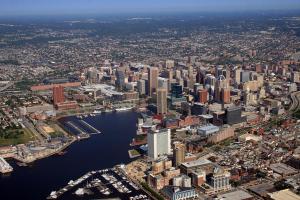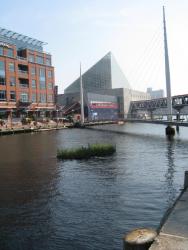BALTIMORE, MD (January 5, 2012)— In the first Inner Harbor health report card of its kind, the ecological health of the harbor and its watershed has been assessed as poor, according to EcoCheck scientists from the University of Maryland Center for Environmental Science and National Oceanic and Atmospheric Administration.
 The report found that the Inner Harbor is polluted with nutrients and sediments that wash into the harbor, leading to oxygen levels in the water that are too low to support fish, crabs and other organisms.
The report found that the Inner Harbor is polluted with nutrients and sediments that wash into the harbor, leading to oxygen levels in the water that are too low to support fish, crabs and other organisms.
When it rains, bacteria from overflowing sewer pipes and waste from family pets are carried into streams and the Harbor, creating unsafe swimming conditions.
Trash from neighborhoods also washes into the waterways, leaching chemicals and creating a breeding ground for harmful bacteria and other pathogens.
“There is too much trash, too many bacteria, and runoff from the streets polluting the Inner Harbor,” said Dr. Bill Dennison, Vice President for Science Applications from the University of Maryland Center for Environmental Science.
“However, this study gives us a baseline for improvement. We have a unique opportunity to change the trajectory of the Inner Harbor and the Chesapeake Bay by looking at novel ways to improve water quality, like floating wetlands and solar paneled oxygen bubblers,” he said.
 Baltimore is a highly urbanized area with a long history of nutrients and sediments washing into local streams and eventually into the Harbor. This runoff feeds algae blooms in the water, which block sunlight to the bottom and limits the growth of grasses and habitat. When the algae dies, it consumes oxygen in the water, leading to low dissolved oxygen conditions, which is bad for fish, oysters and blue crabs.
Baltimore is a highly urbanized area with a long history of nutrients and sediments washing into local streams and eventually into the Harbor. This runoff feeds algae blooms in the water, which block sunlight to the bottom and limits the growth of grasses and habitat. When the algae dies, it consumes oxygen in the water, leading to low dissolved oxygen conditions, which is bad for fish, oysters and blue crabs.
The health of the watersheds that drain into the Inner Harbor—which include the Jones Falls, the Gwynns Falls and the urban areas that collect storm water directly surrounding the Harbor—also scored poorly, according to the study.
Scientists at the University of Maryland Center for Environmental Science used ecological indicators (water quality, aquatic grasses, toxicants in the sediment, organisms living on the bottom) and human indicators (bacteria, fish toxicity and trash) to establish the Inner Harbor’s current health, from the downtown waterfront to Fort McHenry. An annual report card will be produced each year from which citizens can track the health of the harbor and its watershed.
The full report can be found here: http://ian.umces.edu/press/reports/publication/342/state_of_baltimore_harbor_s_ecological_and_human_health_2010_2011-12-14/
In an effort to make the harbor fishable and swimmable by 2020, the Waterfront Partnership of Baltimore asked EcoCheck scientists from the University of Maryland Center for Environmental Science and National Oceanic and Atmospheric Administration to assess the current health of Baltimore’s Inner Harbor and its watershed.
EcoCheck is a partnership program between University of Maryland Center for Environmental Science and National Oceanic and Atmospheric Administration. Each year, EcoCheck produces several report cards to assess the health of Chesapeake Bay waterways. The purpose is to enhance and support the science, management and restoration of Chesapeake Bay through the integration of geographically detailed assessments and forecasts. Effective management is essential for improved health of Chesapeake Bay and EcoCheck helps provide the support and knowledge needed for this effort. For more information, visit http://ian.umces.edu/
UNIVERSITY OF MARYLAND CENTER FOR ENVIRONMENTAL SCIENCE
The University of Maryland Center for Environmental Science harnesses the power of science to transform the way society understands and manages the environment. By conducting cutting-edge research into today's most pressing environmental problems, we are developing new ideas to help guide our state, nation, and world toward a more environmentally sustainable future through five research centers—the Appalachian Laboratory in Frostburg, the Chesapeake Biological Laboratory in Solomons, the Horn Point Laboratory in Cambridge, the Institute of Marine and Environmental Technology in Baltimore, and the Maryland Sea Grant College in College Park. www.umces.edu
# # #
Aerial photo of Inner Harbor by Jane Thomas, IAN Image Library (ian.umces.edu/imagelibrary/).
Floating wetland photo by Sara Powell.

